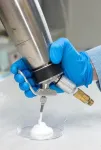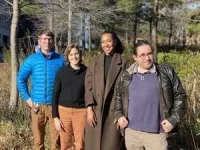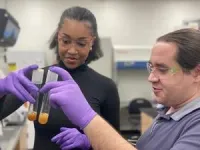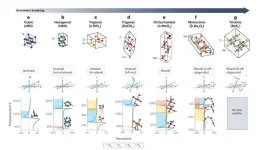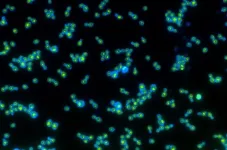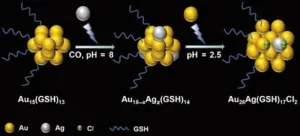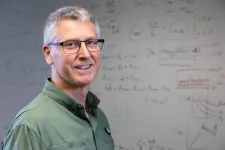(Press-News.org) Did smokers do better than non-smokers in a clinical trial for an experimental cancer treatment? That was the intriguing question that led University of Iowa researchers and their colleagues to develop a drinkable, carbon monoxide-infused foam that boosted the effectiveness of the therapy, known as autophagy inhibition, in mice and human cells. The findings were recently published in the journal Advanced Science.
Looking for ways to exploit biological differences between cancer cells and healthy cells is a standard approach for devising new cancer treatments. But it is a painstaking process that requires a deep understanding of complex cancer biology and often a dose of unexpected insight.
The potential of autophagy inhibitors
Researchers have known for several decades that autophagy, which is the cell’s natural recycling system, is increased in cancer cells relative to healthy cells, suggesting that inhibiting autophagy might be a way to target cancer cells. However, results from almost 20 clinical trials testing autophagy inhibitors have been inconclusive.
"Within those clinical trials they found mixed results; there was some benefit, but for many patients there was no benefit, which really pushed researchers back to the drawing board,” says James Byrne, MD, PhD, UI assistant professor of radiation oncology and biomedical engineering and senior author on the new study.
Searching for insight into why autophagy inhibition only seems to work some of the time, the researchers made the surprising discovery that smokers in two of the previous trials of autophagy inhibitors seemed to do better than non-smokers.
“When we looked at how the smokers did in those trials, we saw an increase in overall response in smokers that received the autophagy inhibitors, compared to (non-smoker) patients, and we also saw a pretty robust decrease in the target lesion size,” Byrne says.
This was an exciting finding for Byrne and his team because smoking is also associated with increased levels of carbon monoxide, a gas molecule that can increase autophagy in cells in a way that researchers think might enhance the anti-cancer effect of autophagy inhibitors.
“We know also that smokers have higher carbon monoxide levels and while we definitely don’t recommend smoking, this suggested that elevated carbon monoxide might improve the effectiveness of autophagy inhibitors. We want to be able to harness that benefit and take it into a therapeutic platform,” says Byrne, who also is a member of University of Iowa Holden Comprehensive Cancer Center.
Carbon monoxide boosts anti-cancer activity of autophagy inhibition
The team already had just such a “platform” to test their ideas. Byrne specializes in crafting gas-entrapping materials (GEMs)—foams, gels, and solids made from safe, edible substances that can be infused with different gas molecules. For this study, the researchers created a drinkable foam infused with carbon monoxide.
When mice with pancreatic and prostate cancers were fed the carbon monoxide foam and simultaneously treated with an autophagy inhibitor, tumor growth and progression was significantly reduced in the animals. The team also showed that combining carbon monoxide with autophagy inhibitors had a significant anti-cancer effect in human prostate, lung, and pancreatic cancer cells in petri dishes.
Ultimately, Byrne hopes to test this approach in human clinical trials.
“The results from this study support the idea that safe, therapeutic levels of CO, which we can deliver using GEMs, can increase the anti-cancer activity of autophagy inhibitors, opening a promising new approach that might improve therapies for many different cancers,” he says.
In addition to Byrne, the research team included UI researchers Jianling Bi, Emily Witt, Megan McGovern, Arielle Cafi, Lauren Rosenstock, Lucas Absler, Srija Machkanti, Kellie Bodeker, Scott Shaw, Vitor Lira, and Michael Henry.
The research team also included scientists from MIT, Harvard Medical School, University of Pennsylvania, Rutgers Cancer Institute of New Jersey, University of North Carolina Wilmington, and Oregon Health and Science University.
END
Drinkable, carbon monoxide-infused foam enhances effectiveness of experimental cancer therapy
2024-01-12
ELSE PRESS RELEASES FROM THIS DATE:
Light-matter interaction: broken symmetry drives polaritons
2024-01-12
An international team of scientists provide an overview of the latest research on light-matter interactions. A team of scientists from the Fritz Haber Institute, the City University of New York and the Universidad de Oviedo has published a comprehensive review article in the scientific journal Nature Reviews Materials. In this article, they provide an overview of the latest research on polaritons, tiny particles that arise when light and material interact in a special way.
In recent years, researchers worldwide have discovered that there are different types of polaritons. Some of them can trap light in a very small space, about the size of a nanometer. That's ...
Neuroscientists identify 'chemical imprint of desire'
2024-01-12
Hop in the car to meet your lover for dinner and a flood of dopamine— the same hormone underlying cravings for sugar, nicotine and cocaine — likely infuses your brain’s reward center, motivating you to brave the traffic to keep that unique bond alive. But if that dinner is with a mere work acquaintance, that flood might look more like a trickle, suggests new research by University of Colorado Boulder neuroscientists.
“What we have found, essentially, is a biological signature of desire that helps us explain why we want to be with some people more than other people,” said senior author Zoe Donaldson, associate professor ...
Trends in cancer mortality disparities between Black and white individuals in the US
2024-01-12
About The Study: Although U.S. age-adjusted cancer mortality rates declined significantly between 2000 and 2020, substantial racial and ethnic disparities persisted for many common and preventable cancers, including female breast and male colorectal cancer. Cancer disparities arise from a confluence of factors, including structural racism, medical mistrust, health care access inequities, poor socioenvironmental conditions, aggressive tumor biology, and genetic ancestry.
Authors: Tomi Akinyemiju, Ph.D., M.S., of the Duke University School of Medicine in Durham, North Carolina, is the corresponding author.
To access the embargoed study: Visit our For The Media website ...
Medicaid expansion under the Affordable Care Act and early mortality following lung cancer surgery
2024-01-12
About The Study: In this study of nearly 15,000 adults with non–small cell lung cancer, Medicaid expansion was associated with declines in 30- and 90-day postoperative mortality following hospital discharge. These findings suggest that Medicaid expansion may be an effective strategy for improving access to care and cancer outcomes in this population.
Authors: Leticia M. Nogueira, Ph.D., M.P.H., of the American Cancer Society in Atlanta, is the corresponding author.
To access the embargoed study: Visit our For The Media website at this link https://media.jamanetwork.com/
(doi:10.1001/jamanetworkopen.2023.51529)
Editor’s ...
Researchers create light-powered yeast, providing insights into evolution, biofuels, cellular aging
2024-01-12
You may be familiar with yeast as the organism content to turn carbs into products like bread and beer when left to ferment in the dark. In these cases, exposure to light can hinder or even spoil the process.
In a new study published in Current Biology, researchers in Georgia Tech’s School of Biological Sciences have engineered one of the world’s first strains of yeast that may be happier with the lights on.
“We were frankly shocked by how simple it was to turn the yeast into phototrophs (organisms that ...
2023: the warmest year on record globally
2024-01-12
Globally 2023 was the warmest year in a series stretching back to 1850, according to figures released today by the Met Office and the University of East Anglia.
2023 is the tenth year in succession that has equalled or exceeded 1.0 °C above the pre-industrial period (1850-1900).
The global average temperature for 2023 was 1.46 °C above the pre-industrial baseline; 0.17 °C warmer than the value for 2016, the previous warmest year on record in the HadCRUT5 global temperature dataset which runs from 1850.
Dr Colin Morice is a Climate ...
Researchers develop technique to synthesize water-soluble alloy nanoclusters
2024-01-12
In recent years, ultrasmall metal nanoclusters have unlocked advances in fields ranging from bioimaging and biosensing to biotherapy thanks to their unique molecular-like properties. In a study published in the journal Polyoxometalates on December 11, 2023, a research team from Qingdao University of Science and Technology proposed a design to synthesize atomically precise, water-soluble alloy nanoclusters.
“The novelty of this study is in a new strategy for the synthesis of water-soluble alloy nanoclusters and a further contribution ...
Clinical predictive models created by AI are accurate but study-specific
2024-01-12
In a recent study, scientists have been investigating the accuracy of AI models that predict whether people with schizophrenia will respond to antipsychotic medication. Statistical models from the field of artificial intelligence (AI) have great potential to improve decision-making related to medical treatment. However, data from medical treatment that can be used for training these models are not only rare, but also expensive. Therefore, the predictive accuracy of statistical models has so far only been demonstrated in a few ...
$900,000 awarded to optimize graphene energy harvesting devices
2024-01-12
U of A physics professor Paul Thibado received a commitment of $904,000 from the WoodNext Foundation, administered by the Greater Houston Community Foundation. The five-year grant will support Thibado’s development of graphene energy harvesters.
“We have successfully developed a process for building graphene energy harvesting device structures,” Thibado said, “but current structures do not harvest enough power. This proposal will allow us to optimize these structures to harvest nanowatts of power, which is enough energy to run sensors.”
Thibado and his colleagues will develop graphene energy harvesting ...
Kessler Foundation scientist awarded prestigious federal grant for novel, mixed-method study on Latinos with multiple sclerosis
2024-01-12
East Hanover, NJ – January 12, 2024 – A research scientist at Kessler Foundation has been awarded a highly competitive Mentored Patient-Oriented Research Career Development Award (K23) from the National Institute on Minority Health and Health Disparities, a part of the National Institutes of Health (NIH).
This $704,054, five-year grant will support one of the first mixed-methods studies aimed at examining barriers to healthcare, cardiovascular risk factors, and accelerated brain aging in Latinos with multiple sclerosis (MS). The Principal Investigator and grant recipient, Cristina A. F. Román, PhD, is currently a research ...
